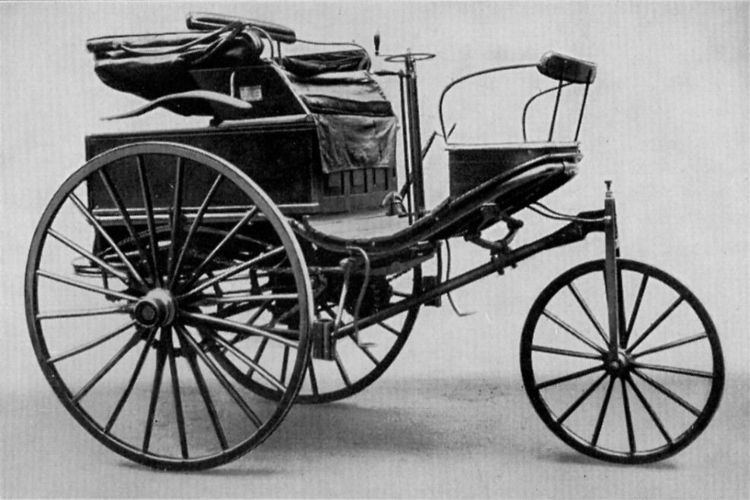 | ||
A road trip is a long distance journey on the road. Typically, road trips are long distances traveled by automobile.
Contents
The first road trip by automobile
The world's first recorded long distance road trip by automobile took place in Germany in August 1888 when Bertha Benz, the wife of Karl Benz, the inventor of the first patented motor car (the Benz Patent-Motorwagen), travelled from Mannheim to Pforzheim (a distance of 106 km (66 mi)) in the third experimental Benz motor car (which had a maximum speed of 10 miles per hour (16 km/h)) and back, with her two teenage sons Richard and Eugen, but without the consent and knowledge of her husband.
Her official reason was that she wanted to visit her mother but unofficially she intended to generate publicity for her husband's invention (which had only been used on short test drives before), which succeeded as the automobile took off greatly afterwards and the Benz's family business eventually evolved into the present day Mercedes-Benz company.
Presently there is a dedicated signposted scenic route in Baden-Württemberg called the Bertha Benz Memorial Route to commemorate her historic first road trip.
The first road trips in North America
The first successful North American transcontinental trip by automobile took place in 1903 and was piloted by H. Nelson Jackson and Sewall K. Crocker, accompanied by a dog named Bud. The trip was completed using a 1903 Winton Touring Car, dubbed "Vermont" by Jackson. The trip took a total of 63 days between San Francisco and New York, costing US$8,000. The total cost included items such as food, gasoline, lodging, tires, parts, other supplies, and the cost of the Winton.
The first woman to cross the American landscape by car was Alice Ramsey with three female passengers in 1909. Ramsey left from Hell's Gate in Manhattan, New York and traveled 59 days to San Francisco, California. Ramsey was followed in 1910 by Blanche Stuart Scott, who is often mistakenly cited as the first woman to make the cross-country journey by automobile East-to-West (but was a true pioneer in aviation).
Expansion of highways in the United States
New highways in the early 1900s helped propel automobile travel in the United States, primarily cross-country travel. Commissioned in 1926, and completely paved near the end of the 1930s, U.S. Route 66 is a living icon of early modern road tripping.
Motorists ventured cross-country for holiday as well as migrating to California and other locations. The modern American road trip began to take shape in the late 1930s and into the 1940s, ushering in an era of a nation on the move.
The 1950s saw rapid growth of ownership of automobiles by American families. The automobile, now a trusted mode of transportation, was being widely used for not only commuting, but leisure trips as well.
As a result of this new vacation-by-road style, many businesses began to cater to road-weary travelers. More reliable vehicles and services made long distance road trips easier for families, as the length of time required to cross the continent was reduced from months to days. Within one week, the average family can travel to destinations across North America.
The greatest change to the American road trip was the start, and subsequent expansion, of the Interstate Highway System. The higher speeds and controlled access nature of the Interstate allowed for greater distances to be traveled in less time and with improved safety as highways became divided.
Travelers from European countries, Australia, and elsewhere soon came to the US to take part in the American idea of a road trip. Canadians also engaged in road trips taking advantage of the large size of their nation and close proximity to destinations in the United States.
Possible motivations
Many people may go on road trips for recreational purpose (e.g. sightseeing or to reach a desired location, typically during a vacation period (e.g., in the US, driving to Disneyland from Oregon). Other motivations for long distance travel by automobile include visitation of relatives, who may live far away, or relocation of one's permanent living space.
Distance and location of road trips
Generally, while road trips can occur at any mass of land, large masses of land are the most common location for the occurrence of road trips. The most popular locations for road trips include Canada, Mainland U.S., and Central Europe. This is because, since these areas of land are so composite, travel is more seamless, accessible, and efficient, than travel within smaller or non-contiguous, remote countries, such as Nauru, in addition to the fact that these countries tend to offer more points of interest than smaller ones. This may also be due to the distance required to qualify as a road trip, which residents of smaller bodies of land may find themselves incapable of achieving.
While there is no consensus as to what distance or time must be traveled/spent in order for the event to qualify as a road trip, it is a commonly held belief that commuting by means of automotive transportation should not qualify as a road trip, regardless of the distance. Some argue that travel may not require a set distance to qualify as a road trip.
Road trips in the United States
In the United States, a road trip typically implies leaving the state, or in extreme cases, leaving the country for others such as Canada or Mexico. However, in larger states, travel within the state may also be considered a road trip.
Literature
Photography
Films with road trips as a major theme
Many movies and other forms of media have been made which focus upon the topic of road trips, including the namesake. Many tend to be comedic in nature, although road movies such as Easy Rider and Thelma and Louise exemplify the American dream.
Road Tripping in Music
Many songs approach the idea of road tripping, as often music is listened on the radio during road trips.
